Introducing Edward J. Nevin, Jr ... Medical Malpractice
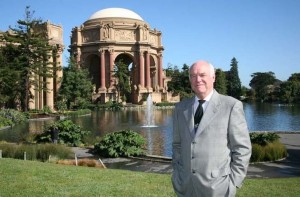 "I pride myself in being known for my integrity, both from clients and from my peers.....being professional and dedicated to the task at hand and using integrity to represent clients--allowing the law to work as it should. You always carry a connection with those you have represented, after having worked so closely with them and their family--you always have those emotional ties. The satisfaction comes from knowing that you provided the necessary means for them to have their needs met, going forward."
"I pride myself in being known for my integrity, both from clients and from my peers.....being professional and dedicated to the task at hand and using integrity to represent clients--allowing the law to work as it should. You always carry a connection with those you have represented, after having worked so closely with them and their family--you always have those emotional ties. The satisfaction comes from knowing that you provided the necessary means for them to have their needs met, going forward."
- Ed Nevin
" A nation reveals itself not only by the men it produces, but also by the men it honors, the men it remembers." - John F. Kennedy
In 2003, Ed was elected President of the American Board of Trial Advocates--one of the foremost trial lawyers associations in the world. During his tenure as President, Ed advanced ABOTA and the rule of law internationally through special programs in honor of lawyers and judges who lost their lives in defending human rights and the rule of law--in Czechoslovakia, Italy and Northern Ireland.
Edward J. Nevin, Jr. is a highly regarded, experienced attorney who specializes in civil litigation, including medical malpractice, labor law, and personal injury. He brings over 40 years of experience to his firm—the Law Offices of Edward J. Nevin—which serves the San Francisco Bay area. Mr. Nevin was admitted to the State Bar of California in 1967, and in the years since has tried more than 50 cases to jury verdict and has won millions of dollars for his clients.
Mr. Nevin's achievements have not gone unnoticed by the legal community. He has been honored with membership into invitation-only professional societies, including the International Society of Barristers, the American College of Trial Lawyers, and the International Academy of Trial Lawyers. He is also an advocate of the American Board of Trial Advocates.
Edward Nevin is very involved with professional associations in the state of California. He served as president of the San Francisco Trial Lawyers Association and sits on the Board of Governors of the California Trial Lawyers Association. In addition, he is a member of many national, local, and state associations such as the Supreme Court Historical Society and the Lawyers Club of San Francisco.
When not in the courtroom, Mr. Nevin also finds time to volunteer in his community. He is a member of The Association for the Severely Handicapped, sits on the board of Legal Services for Children in the San Francisco area, and founded the Trial Lawyers Child Abuse Panel, which he also chairs.
Education:
• B.A., 1963, St. Patrick's College Seminary, Menlo Park, CA
• J.D. 1967, Hastings College of Law - San Francisco, CA
Admitted To The Bar:
• 1967, California State Bar
PROFESSIONAL ASSOCIATIONS BY INVITATION ONLY
• Advocate, American Board of Trial Advocates - 1984-Present
• Fellow, International Society of Barristers - 1988-Present
• Fellow, American College of Trial Lawyers - 1992-Present
• Fellow, International Academy of Trial Lawyers - 1995-Present
PROFESSIONAL OFFICES HELD
• Board Member, International Society of Barristers, 1998-2004
• National Board Member, American Board of Trial Advocates, 1996-1998
• National Treasurer, American Board of Trial Advocates, 1998-2000
• National Vice President, American Board of Trial Advocates, 2000-Present
• National President, American Board of Trial Advocates, 2003
• President, San Francisco Chapter, American Board of Trial Advocates, 1996
• Chair Of Board, CAL-ABOTA (Represents All Eight California ABOTA Chapters), 1997
• President, Lawyers Club of San Francisco, 1990
• President, San Francisco Trial Lawyers Association, 1983
• Board of Governors, California Trial Lawyers Association
PROFESSIONAL ASSOCIATIONS BY MEMBERSHIP APPLICATION:
• American Trial Lawyers Association, 1972-Present
• Consumer Attorneys of California, Board of Governors, 1972-1975; (Former Northern California Education Chair)
• San Francisco Trial Lawyers Association, Board of Governors, 1972-1982; President 1983
• American Board of Professional Liability Attorneys, 1981-Present
• National Board of Trial Advocacy, 1986-Present.
• Lawyers Club of San Francisco, President, 1990
• State Bar of California (Delegate, Conference of Delegates)
• San Francisco Bar Association
• The Association for the Severely Handicapped, 1985-Present
• World Jurist Association, Washington, D.C.
• U.S. Supreme Court, Historical Society
• California Supreme Court, Historical Society
• Board Member, Litigation Section, San Francisco Bar Association
• Board Member, Legal Services for Children, San Francisco
• Founder/Chair, Trial Lawyers Child Abuse Panel
• Director, Sequoia National Bank, San Francisco, 1998-1999

“When I come out on the road of a morning, when I have had a night's sleep and perhaps a breakfast, and the sun lights a hill on the distance, a hill I know I shall walk across an hour or two thence, and it is green and silken to my eye, and the clouds have begun their slow, fat rolling journey across the sky, no land in the world can inspire such love in a common man.” - Frank Delaney, Ireland
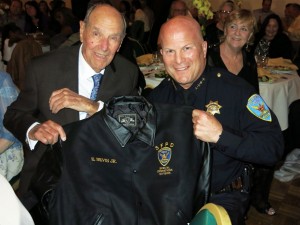 Not too long ago—August 26, 2014--Ed Nevin’s [Jr.] father, Edward Nevin, celebrated his 100th birthday. It was held at the Irish Cultural Center in San Francisco, the city the Nevin family has lived since 1905—it sold out the center. Birthday guests numbering over 350 lined up in the auditorium to pay their respects to someone they considered to be a “legend.” Highly respected, Edward Nevin [Ed’s father] served the San Francisco Police Department with great distinction for 34 years. He began his career as an officer at the Richmond Station, followed by posts of great distinction such as Chief of Chinatown detail, Director of Special Services [aka Vice Squad], Commander of the S.F. Housing Authority Police, and ultimately as Chief of the S. F. International Airport Police—a post he retired from in 1976. Edward Nevin was the seventh son of seven children born to Irish Immigrant parents in 1914. These immigrants were Ed’s grandparents and he recounts how they ended up in San Francisco:
Not too long ago—August 26, 2014--Ed Nevin’s [Jr.] father, Edward Nevin, celebrated his 100th birthday. It was held at the Irish Cultural Center in San Francisco, the city the Nevin family has lived since 1905—it sold out the center. Birthday guests numbering over 350 lined up in the auditorium to pay their respects to someone they considered to be a “legend.” Highly respected, Edward Nevin [Ed’s father] served the San Francisco Police Department with great distinction for 34 years. He began his career as an officer at the Richmond Station, followed by posts of great distinction such as Chief of Chinatown detail, Director of Special Services [aka Vice Squad], Commander of the S.F. Housing Authority Police, and ultimately as Chief of the S. F. International Airport Police—a post he retired from in 1976. Edward Nevin was the seventh son of seven children born to Irish Immigrant parents in 1914. These immigrants were Ed’s grandparents and he recounts how they ended up in San Francisco:
“My grandfather came alone in 1905, directly from the port of New York. He took about a year tending the horses at the Drayage Company in downtown San Francisco to raise the money to bring my grandmother and his then 3 children from Ireland. The owner of the Drayage Company loved him because he was such a good horse handler that he was able to save all of them by running them down Old Mission Road to South San Francisco when SF was hit with the famous 1906 earthquake and fire, which destroyed the City. “
Edward and his wife Mazie likewise had seven children, of whom Ed Nevin, Jr. was one. If you mention the name “Nevin” to those acquainted with San Francisco history, it is a name met with a great deal of respect and admiration. It is a family known for its integrity, work ethic, determination, decency, honesty, loyalty, commitment to the community, to each other, and to truth and justice. This is the family that Ed Nevin, Jr. was born into. He was raised to live his life honorably and with integrity, to be respectful, courteous and kind—and equally importantly—to make a difference in the lives of others. Therefore likewise, if you mention Ed Nevin, Jr. to anyone acquainted with San Francisco history or to anyone in the legal community, it is met with that same degree of respect and admiration; for he has lived his life as a true and worthy representative of his family name. This is the family legacy ..... and quite a legacy it is.
Parents of any large, devout Irish Catholic family—such as the Nevin family--usually expect one of their children to become a priest; Ed’s parents likewise assumed the same. It was always hoped that one of the children would devote their life to the religion that had continually served as the strong foundational structure of the family. Ed’s mother Mazie had always hoped or somewhat expected, that of all her children, that “calling” perhaps would have fallen upon Ed. He did in fact go to school with the intention of coming out a priest, but instead became a lawyer—he was intrigued by the sense of deep tradition inherent within the legal system and he respected the high degree of integrity and professionalism that it intrinsically represented. Furthermore, all of his studies and natural interests, seemed to gravitate toward the law and he ultimately felt compelled to move in that direction. That decision, however, was accompanied by the sense that he had most likely deeply disappointed his beloved mother in the process. He was to find out years later, much to his surprise and consolation, that this was not true.
One of the most rewarding and challenging cases that Ed encountered involved his own family. It was related to biological testing that was done in the early fifties in San Francisco, which resulted in the death of his grandfather, whom he was named after. It was a particularly satisfying case for Ed in that he was representing his family. Ed filed the case in the U. S. District court, and he said at the time, "My grandfather wouldn't have died except for that, and it left my grandmother to go broke trying to pay his medical bills." The lower court ruled that the government was immune from lawsuits. The Nevin family appealed the suit all the way to the U.S. Supreme Court, which declined to overturn lower court judgments.
In 1951, Edward J. Nevin, Ed’s grandfather, checked into a San Francisco hospital, complaining of chills, fever and general malaise. Three weeks later, he died of a bacterial heart infection. The doctors said it was an infection caused by the bacterium serratia marcescens. Decades later, Ed’s family learned what they believe was the cause of the infection, which was also linked at the time to the hospitalizations of ten other patients.
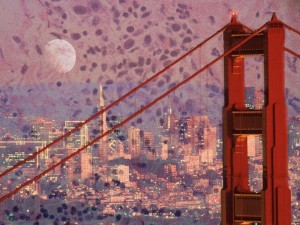 In Senate subcommittee hearings in 1977, the U.S. Army revealed that weeks before Mr. Nevin died, the Army had staged a mock biological attack on San Francisco; from offshore, US Navy ships had secretly sprayed the City with the live bacteria—serratia marcescens—and other agents they thought to be harmless. The “point” of this “exercise,” was to see what might happen if another country launched a real germ-warfare attack against the United States. The experiment, which involved blasting a bacterial fog over the entire 49-square-mile city from a Navy vessel offshore, was rather clinically and coldly notated by the Army in a 1951 classified report: "It was noted that a successful BW [biological warfare] attack on this area can be launched from the sea, and that effective dosages can be produced over relatively large areas."
In Senate subcommittee hearings in 1977, the U.S. Army revealed that weeks before Mr. Nevin died, the Army had staged a mock biological attack on San Francisco; from offshore, US Navy ships had secretly sprayed the City with the live bacteria—serratia marcescens—and other agents they thought to be harmless. The “point” of this “exercise,” was to see what might happen if another country launched a real germ-warfare attack against the United States. The experiment, which involved blasting a bacterial fog over the entire 49-square-mile city from a Navy vessel offshore, was rather clinically and coldly notated by the Army in a 1951 classified report: "It was noted that a successful BW [biological warfare] attack on this area can be launched from the sea, and that effective dosages can be produced over relatively large areas."
In 1980, Ed brought a wrongful death lawsuit against the Department of the Army, representing 67 members of the Nevin family; all of the children, grandchildren and great-grandchildren of Edward Nevin. Several weeks into the trial, Ed reduced his request for punitive damages from the government from 11 million to $300,000. He stated at the time, ''We are far more concerned about principle than about monetary damages, and we have been motivated by the horrible specter of the Government conducting potentially fatal tests on an uninformed public.'' The Government’s assertion was that it believed at the time that the bacteria were harmless. However, it was established in trial that the bacteria could be harmful to a small group of people if their natural immunities had already been compromised by sickness or illness.
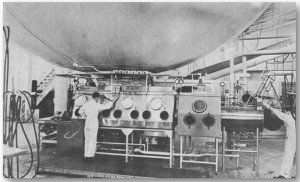 Early in the trial, Judge Conti asked John M. Kern, an assistant United States Attorney, why the germ warfare test could not have been conducted in an uninhabited or less populated area. ''The results would not have been valid,'' Mr. Kern asserted, adding that the experiment was intended to simulate an attack on a densely populated urban area with tall buildings.
Early in the trial, Judge Conti asked John M. Kern, an assistant United States Attorney, why the germ warfare test could not have been conducted in an uninhabited or less populated area. ''The results would not have been valid,'' Mr. Kern asserted, adding that the experiment was intended to simulate an attack on a densely populated urban area with tall buildings.
Witnesses called by Mr. Kern included retired military personnel and scientists. One of the principal defense witnesses was a former technical director of bacteria warfare testing at Camp Detrick, Md., who had in fact ordered the 1950 experiment. He adamantly maintained that the test was safe and that it was justified by the danger an attack on the West Coast would pose. He stated, ''The Bay area populace should be pleased that the danger of attack is somewhat relieved.'' Another defense witness who was a researcher at the Centers for Disease Control in Atlanta, told the court that there was ''less than one chance in 100'' that the germ warfare experiment killed Mr. Nevin. He asserted that the strain of bacteria used in the test had little or no immunity to antibiotics, and he speculated that in all likelihood, a different, more virulent strain of bacteria in Mr. Nevin's hospital room had caused his death. His assertion was contradicted by Dr. Stephen Weitzman, who was called by the Nevin family. Dr. Weitzman was a physician and a former professor of microbiology at the State University of New York at Stony Brook. He testified that, ''The coincidence of time and place is absolutely overwhelming. There is a very good probability that the organisms used by the Army are the organisms that killed Edward Nevin.''
Members of the Nevin family, who nearly filled Judge Conti's courtroom on most days of the trial, referred to Edward J. Nevin as ''our patriarch.'' They said they had not been aware of the germ warfare testing and had not questioned the cause of his death until newspaper articles on military germ warfare experiments appeared in 1976.
US District Court Judge, Samuel Conti, found in favor of the government on all issues. In Ed’s words, “I knew it wasn’t a case that could be “won,” as it was against the U.S. government, but it was a story that needed to be told.” The public benefit resulted from the fact that the National press was seated in the jury box, because juries are not allowed for suit against the United States Government. The press carried daily stories and thus the historical facts were made known across the nation by both newspapers and television and radio. The Story was also told by Dan Rather on 60 Minutes.
 The American Board of Trial Attorneys (ABOTA) came into existence in 1958. It was the first law association comprised of both plaintiff and defense attorneys, who were united in one common goal: “To recognize how America’s greatness lies in its people, and in its people lies the foundation of justice—trial by jury.” Integral to this process, was to find a way to properly certify competent trial attorneys, so that America would have a country-wide, “Inn of Court” like what exists in England. ABOTA would certify the right lawyers to try cases, establish a much higher standard in respect to what constitutes a true trial attorney, as well as foster a greater sense of community and collegiality similar to what exists in England among their barristers.
The American Board of Trial Attorneys (ABOTA) came into existence in 1958. It was the first law association comprised of both plaintiff and defense attorneys, who were united in one common goal: “To recognize how America’s greatness lies in its people, and in its people lies the foundation of justice—trial by jury.” Integral to this process, was to find a way to properly certify competent trial attorneys, so that America would have a country-wide, “Inn of Court” like what exists in England. ABOTA would certify the right lawyers to try cases, establish a much higher standard in respect to what constitutes a true trial attorney, as well as foster a greater sense of community and collegiality similar to what exists in England among their barristers.
In 1994, the ABOTA president Robert C. Baker expressed it in the following way, “It doesn’t matter whether you’re in Omaha or New York City, [ABOTA members] share a common bond.”
In 1984, Ed was invited to become a member of ABOTA. He was elected President of the San Francisco Chapter in 1996; He became Treasurer from 1998-2000 and he was elected National President in 2003-2004. Noting that ABOTA recognized the need to archive and preserve its past, in 2003, Ed commissioned a national committee to videotape and archive interviews with ABOTA’s founders and past presidents. Charting ABOTA’s growth, these interviews place into context how ABOTA began with 49 members and had grown to more than 6,300 members [In 2003] with a presence in all 50 states and Washington, D.C. Membership also included judges and international members.
“A nation reveals itself not only by the men it produces, but also by the men it honors, the men it remembers.” - John F. Kennedy
During his tenure as president, Ed advanced ABOTA and the rule of law internationally through special programs in honor of lawyers and judges who lost their lives in defending human rights and the rule of law in Czechoslovakia, Italy and Northern Ireland. In so doing, he greatly contributed to the establishment of ABOTA as a leading trial lawyer’s organization.
In 1999, at the ABOTA International Meeting in Florence, Italy, an award known as “The Courageous Advocacy Award,” was collectively given to 24 murdered lawyers, judges and their families for exposing the blatant corruption and terrorism that had undermined the entire legal system of Italian society. In 2003, at the ABOTA International Meeting in Belfast, Northern Ireland, this same collective “Courageous Advocacy Award” was collectively given in memory of 13 judges, barristers and solicitors who were maimed or murdered while displaying extraordinary courage and unwavering commitment to the rule of law following the 1968 political and social unrest in that country known as “The Troubles.”
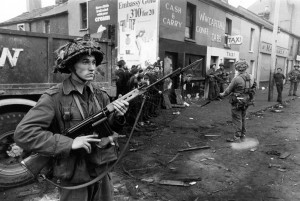 In 1921, Ireland gained independence from Britain. However, the majority of those living in Northern Ireland were protestant, so they remained under British rule. These Protestants received favored treatment from the British, which caused contention with the Catholics still living in Northern Ireland. The "Troubles," began in the late 1960’s when Catholic Irish nationalists, favoring unification with the Irish Republic to the south, began a campaign against Britain and the Loyalist Protestant paramilitary groups who supported continued British rule. Extreme violence erupted on both sides. Over some 30 years, more than 3,500 people were killed—soldiers, suspected informers, militia members and civilians caught in bombings and crossfire—and thousands more were injured, some maimed for life.
In 1921, Ireland gained independence from Britain. However, the majority of those living in Northern Ireland were protestant, so they remained under British rule. These Protestants received favored treatment from the British, which caused contention with the Catholics still living in Northern Ireland. The "Troubles," began in the late 1960’s when Catholic Irish nationalists, favoring unification with the Irish Republic to the south, began a campaign against Britain and the Loyalist Protestant paramilitary groups who supported continued British rule. Extreme violence erupted on both sides. Over some 30 years, more than 3,500 people were killed—soldiers, suspected informers, militia members and civilians caught in bombings and crossfire—and thousands more were injured, some maimed for life.
ABOTA later said of these awards, “The ‘Courageous Advocacy Award’ has been given by our organization in honor of judges or advocates anywhere in the world who have demonstrated courage in the performance of their professional duties and who have displayed a strict adherence to the rule of law even at great risk to their personal freedom and safety.”
Ed was in attendance and served as Master of Ceremonies, when the “Courageous Advocacy Awards” were presented in Italy in 1999 and in Ireland in 2003. In Italy, the awards ceremony was held at The Palazzo Medici Riccardi, in the Cianguie Cento Room. In Belfast, it was presented at the Belfast City Hall. Ed read out the proclamations to the honored guests and members. He was extremely proud to be a part of such momentous occasions which honored those who had sacrificed all they had for the rule of law and for justice.
 The Irish have an innate sense of both realism and symbolism; resulting from the turbulence and violence of a history that has been deeply imprinted upon a country that exudes a deep peace and unsurpassed, transcendent beauty. Yes, one might well see the innumerable, misty waterfalls as magical prisms serving as “portals” to “another world,” but they also suggest the lure of the escape from this one; mystical disappearing and reappearing rainbows—not only the promise of hope, luck and good fortune, but the constant reminder of their elusive and transitory nature; dramatic windswept mountains—timeless fortresses of gods and goddesses standing in stark contrast with the mortality of man; spectacular severed cliffs rising up sharply from a raging sea—tombstones of the immortals, but equally, an unforgettable defiance of fate and the triumph of tenacity……And those ghostly, abandoned villages—nagging reminders of hardship, homelessness and despair, but also hard choices and the new beginnings which are born out of them.
The Irish have an innate sense of both realism and symbolism; resulting from the turbulence and violence of a history that has been deeply imprinted upon a country that exudes a deep peace and unsurpassed, transcendent beauty. Yes, one might well see the innumerable, misty waterfalls as magical prisms serving as “portals” to “another world,” but they also suggest the lure of the escape from this one; mystical disappearing and reappearing rainbows—not only the promise of hope, luck and good fortune, but the constant reminder of their elusive and transitory nature; dramatic windswept mountains—timeless fortresses of gods and goddesses standing in stark contrast with the mortality of man; spectacular severed cliffs rising up sharply from a raging sea—tombstones of the immortals, but equally, an unforgettable defiance of fate and the triumph of tenacity……And those ghostly, abandoned villages—nagging reminders of hardship, homelessness and despair, but also hard choices and the new beginnings which are born out of them.

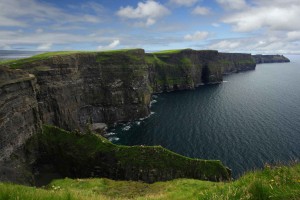
To a young man growing up in San Francisco, you might well wonder how Ed would know anything of this; but Ireland isn’t just a country or a home. Being Irish is a state of mind, a way of being, a way at looking at life regardless of where you grow up or how many generations have passed. It is something you always carry with you because it is who you are, and it is your heritage. When Ed made the decision to become a Medical Malpractice lawyer, he felt it would put him in a unique position to help those in desperate need. He also did so with the realization that it appealed to his sense of tradition, honor, integrity and compassion—while enabling him to acknowledge and apply both the realistic and visionary aspects of his nature. Committing to make a difference in the lives of those who sought his help meant accepting the harsh realities of a tragic situation, but still visualizing a solution and being compelled to transform it to a new reality. This is what lies at the very heart of the practice of law for Ed.
One of Yeats best known works is a poem entitled, The Stolen Child. In it the “faeries” of the supernatural world, try to lure away a child from the world of reality, with the line,“For the world is more full of weeping than you can understand.” In its broadest sense, it could be indicative of the struggle between living a “visionary” life and one that is considered to be more “realistic.” Surrounded as he was by both, in Ireland – the world of myths and folklore versus the world of much harsher realities of the time and age he lived in—one can well understand why Yeats was so intrigued by the subject. Being raised in a strong Irish Catholic family, as Ed was, one can well understand the dilemma he faced with regard to his life’s pursuit. With the unspoken expectation placed upon Ed to be a priest, versus becoming a lawyer, it seems very clear the perception surrounding either—life in the priesthood perhaps being considered to be in pursuit of a higher calling. However, Ed found a way to bridge “both” worlds by applying his idealistic or visionary self to the practical world of law—and thereby creating, and achieving, justice for his clients.

Over the years, Law has become a way for Ed to utilize his most Irish attributes, by extending the hand of compassion, passing on some hard won wisdom, and by truthfully and respectfully sharing the lives and stories of those who have experienced deep tragedy. But most importantly, it is a means of helping families stay strong and move forward after life-altering events.
Ed says, “I pride myself in being known for my integrity, both from clients and from my peers. Being professional and dedicated to the task at hand and using integrity to represent clients - allowing the law to work the way it should.” He continues, “You always carry a connection with those you have represented, after having working so closely with a client and their family. You always have those emotional ties. The satisfaction comes from knowing that you provided the necessary means for the injured party to have their needs met, going forward.” And with regard to his belief that he had disappointed his mother by becoming a lawyer, Ed had this to say, “After one of my first trials, where she was present, after the closing arguments, she said to me, ‘You are still a priest, just in a different way, to a different congregation.’ That made me realize that she wasn’t disappointed in me—and that meant everything to me.”
Over the past 40 years, Mr. Nevin has tried more than 50 cases to jury verdict. The following are representative trial cases handled over the past 40 years.
McDonough v. Regents of University of California
Michael McDonough was a 10 ½ year old boy at the time of the 10-11-12/99 trial. On his first day of life in 6/89, he suffered catastrophic brain damage with resultant severe developmental disability and brain damage caused behavioral problems. These injuries were caused by the failure of the newly arrived residents and the nursing personnel to diagnose Group B Streptoccocus infection which the child received in the course of birth and which should have been diagnosed on the first day of his life. ($51 million future damages verdict for plaintiff which was equal to $6 million in present value.
Nevin v. USA
1980 lawsuit against Department of The Army for 1950 bacteriological warfare experimentation in San Francisco. From offshore US Navy ships The Army sprayed the City with live bacteria, serratia marcescens. Edward J. Nevin, Mr. Nevin's grandfather, died of infection from that organism a few weeks thereafter. This action was brought on behalf of all of the children, grandchildren and great-grandchildren of Edward Nevin. US District Court Judge, Samuel Conti, found in favor of the government on all issues, but the public benefit was that the National press was seated in the jury box, because juries are not allowed for suit against the United States Government. The press carried daily stories and thus the historical facts were made known across the nation by both newspapers and television and radio. The Story was also told by Dan Rather on 60 Minutes.
Leung v. Chinese Six Companies
Wrongful Death; 100,000 firecrackers were set off in the entryway of the Chinese Six Companies Building in San Francisco. Mr. Leung, the janitor was overcome by the smoke and died. Employer, Chinese Six Companies had no workers compensation insurance and were thus subjected to a substantial verdict in San Francisco Superior Court.
Samimi v. Southern Pacific/Amtrak
Death of 16 year old boy, who was driving his family car to deliver pizza from the refugee Afghanistan family pizza restaurant, when his car was struck by high speed passenger train. Southern Pacific was found to be negligent in failing to provide electronic gate protection at the last unguarded railroad crossing in all of Alameda County.
Marshall v. Continental Metroplex
Single Family Dwelling; Construction Defects/Breach of Fiduciary Duty.
Robinson v. Guidotti
Institutional mistreatment of severely developmentally disabled child. Substantial award despite defense expert testimony that he was too disabled to appreciate what was done to him.
Schortgen v. Kaiser
Carpenter disabled by synostosis, i.e. loss of pronation supination of major forearm due to post surgical malpractice, which caused radius and ulnar bones to grow together.
Ruby Henry v. Winthrop Labs
Addiction to Chronic Pain Medication-Talwin-Drug company marketed its use as first non addictive, long term pain medication.
Lipton v. Kaiser
Facial nerve (5th Cranial Nerve) injury by surgeon in the course of mastoidectomy with resultant one sided facial collapse, loss of eyelid function, loss of spittle control.
Olympic Club v. Barrett
Destruction of San Francisco Olympic Club sewer system from construction of Barrett Motor Inn across the street. Damages of several hundred thousand dollars for replacement sewer system which required electrical pumping instead of former gravity flow.
Moreno v. Fey Manufacturing
149 CA3d 23. Strict Product Liability for an aftermarket bumper, manufactured and installed by defendant. The motorcyclist lost his leg to a pickup truck which had a significant gap between the rear fender and the aftermarket wrap around bumper. As the truck pulled out to pass on two lane highway, Highway 41, the leg of the oncoming motorcyclist lodged in the space between the rear bumper and fender and it was violently amputated. The danger of extended mirrors, bumpers and other vehicle elements should be foreseeable by the manufacturer, who must be held strictly liable for such dangerous defects in its product.
Ballard v. Waltrip
Nationally ranked quarterhorse rider injured when struck by jackknifing tractor trailer when she volunteered to rescue and subdue a horse which was loose in freeway center divider. Her plan for promotion of her quarterhorse training business was dashed when her hand injury disabled her from ever again competing in high level national events.